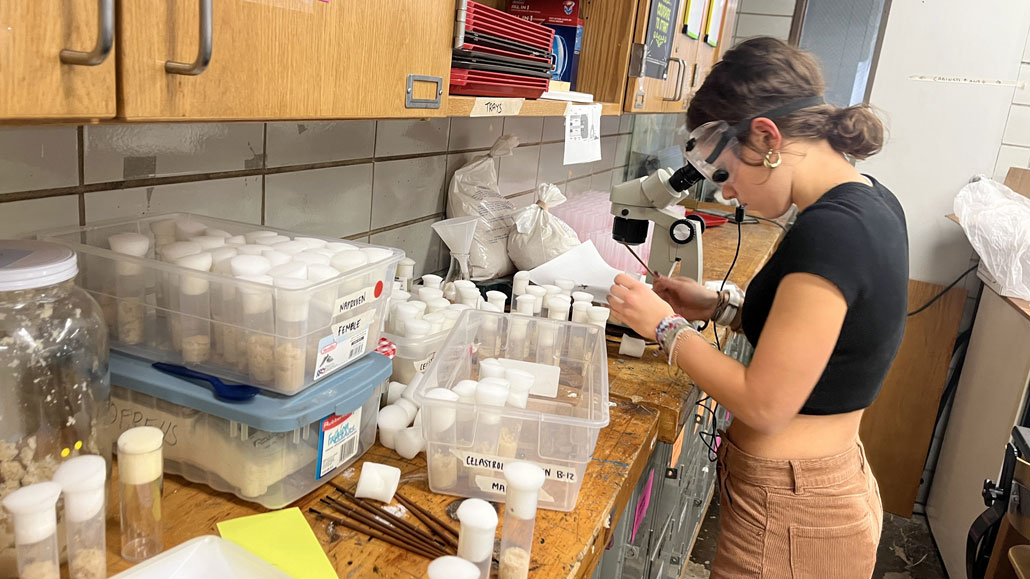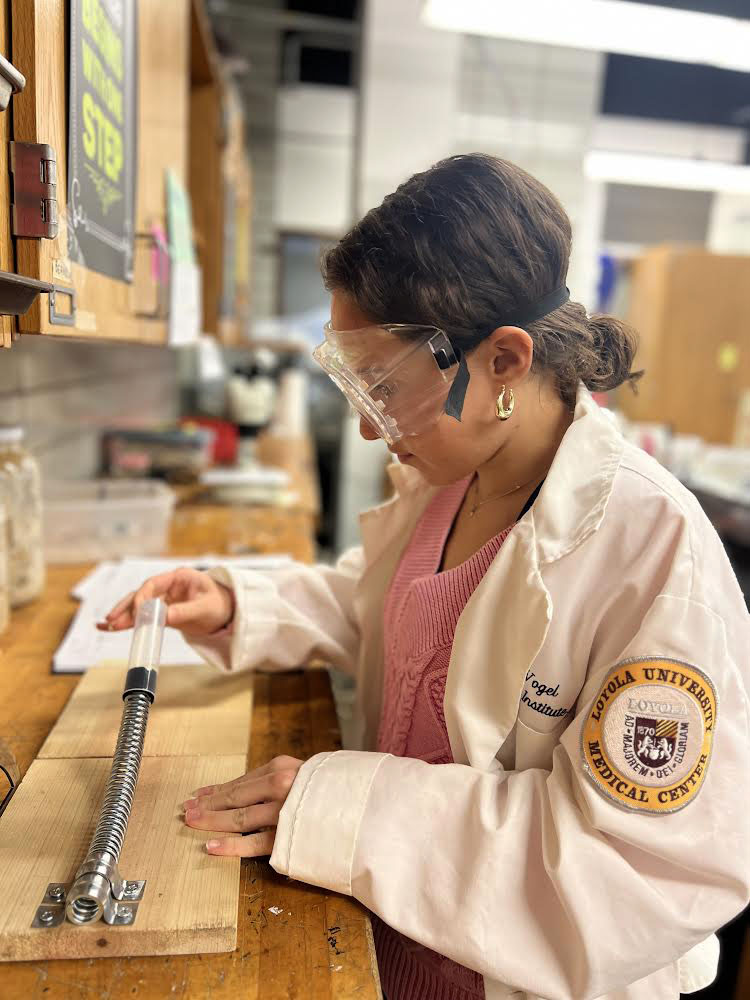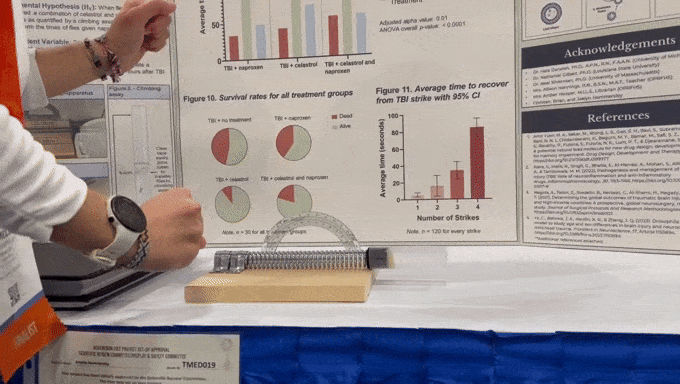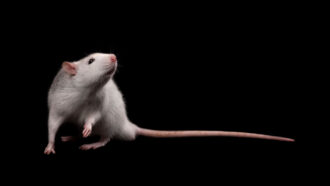Herbal medicine could help recovery after concussion
Combining a compound with a pain reliever helped fruit flies bounce back from a brain injury

People with concussions often take pain relievers called NSAIDs. But these can have side effects, especially if used in high doses. At the Regeneron ISEF competition this week, Amelia Hammersley shows that a plant substance can reduce the dose of NSAIDs needed to treat concussions.
Allison Hennings
LOS ANGELES, Calif. — When Amelia Hammersley was in sixth grade, her younger sister went to the hospital after hurting her head in a fall. Her diagnosis: a concussion. That’s a temporary type of traumatic brain injury, or TBI.
People with TBIs often take pain medicines to ease symptoms, such as headaches. But heavy use of NSAIDs, a common type of pain reliever, can come with serious side effects, especially if taken at high doses or for a long time.
Amelia, now 16, has now shown that a plant substance could supplement NSAIDs’ helpful effects. Called celastrol (Seh-LASS-trawl), it comes from the thunder god vine (Tripterygium wilfordii). This compound has anti-inflammatory properties. People in China have used this native plant for hundreds of years to treat various health problems.
The teen’s research suggests that TBI sufferers would need less of a potentially toxic NSAID if it’s taken along with celastrol.
“My sister led me to neuroscience,” notes the teen. Amelia is a junior at Oak Park and River Forest High School in Oak Park, Ill.
She showcased her findings here, this week, at the Regeneron International Science and Engineering Fair (ISEF). This competition is a program of the Society for Science (which also publishes this magazine).

Educators and Parents, Sign Up for The Cheat Sheet
Weekly updates to help you use Science News Explores in the learning environment
Thank you for signing up!
There was a problem signing you up.
Giving fruit flies TBIs
Inflammation contributes to a concussion’s harmful effects. Amelia turned up prior research suggesting that celastrol might help the brain recover from injuries. She also found studies showing that the plant compound hinders a biological pathway in the brain that leads to inflammation.

Celastrol “has been studied, but not really in combination with [other] things,” Amelia says. To see if it might lower the dose of an NSAID needed to help the brain bounce back from a TBI, Amelia worked with an animal model: fruit flies (Drosophila melanogaster). The same brain pathway promotes inflammation in both fly and human brains.
She purchased a lot of fruit flies — at least 120. First, she tested how quickly each fly could climb a clear tube that was 9.4 centimeters (about 4 inches) tall. They were in search of a treat: moldy raspberry juice. The flies took a little less than a minute, on average, to complete the climb.
Then, one by one, Amelia stuck each fly into another tube. It was attached to a spring lying horizontally. One end of that spring was attached to a plank of wood below. The spring’s free end held the tube with a fly.
Again and again, Amelia pulled the tube upward so that the spring stretched straight up at a 90-degree angle. Then she let it go. This released the tube holding the fly. As it slammed down onto a surface below, the fly got knocked against the wall of the tube. She did this four times for each insect. It left each of them with a TBI.
Afterward, the teen again tested her flies’ climbing ability. Most were now so disoriented that they took more than two minutes, on average, to climb up their tubes. Several didn’t even bother to try, Amelia says. Instead, these dazed bugs ran around the bottom of their tubes in circles.

Treatment helped the flies recover
Amelia later transferred the flies to new tubes. Thirty of them got food into which she mixed an NSAID called naproxen at a dose of 200 micrograms (µg) per milliliter (ml) of food. Another 30 got food laced with celastrol, also at 200 µg per ml. A third group of 30 flies received food treated with both naproxen and celastrol, each medicine at 100 µg per ml. The last group of 30 flies got plain food.
See Amelia’s project and watch her give a short description of her work at her Project Board.
Twenty-four hours later, Amelia tested the flies once more. Some had died since their TBIs. Only 55 percent of the unmedicated flies lived. Six in every 10 that got just naproxen lived. The other treatment groups fared better. Eight in 10 of those treated with both medications lived. And in the celastrol group, nine in every 10 survived.
All survivors were given one last chance to climb up to a treat. The untreated flies took an average of 112 seconds to reach the treat. The celastrol group needed about 71 seconds. The naproxen group took about 54 seconds and flies given both celastrol and naproxen made the climb in 55 seconds. Those last speeds were similar to how they had performed before their TBIs.
Amelia hopes to continue working on this project in the future. She wants to use more sophisticated lab equipment to investigate the brain’s inflammation pathways.
Do you have a science question? We can help!
Submit your question here, and we might answer it an upcoming issue of Science News Explores
But based on her findings, Amelia says that this low-cost, readily available plant substance “could help make medicine more accessible” in places where health care is costly or hard to get. It could also reduce long-term toxicity from TBI treatment.
Amelia is among nearly 2,000 high school finalists from almost 70 countries, regions and territories who competed this week. Regeneron ISEF, which will dole out close to $9 million in prizes this year, has been run by Society for Science since this organization created the annual event in 1950.







